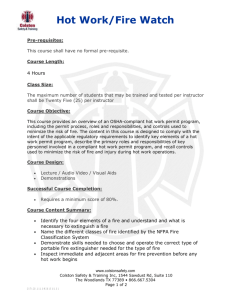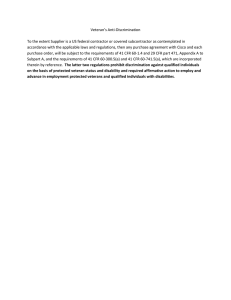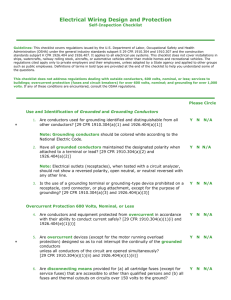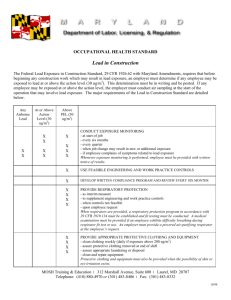check10. - Rutgers School of Public Health
advertisement
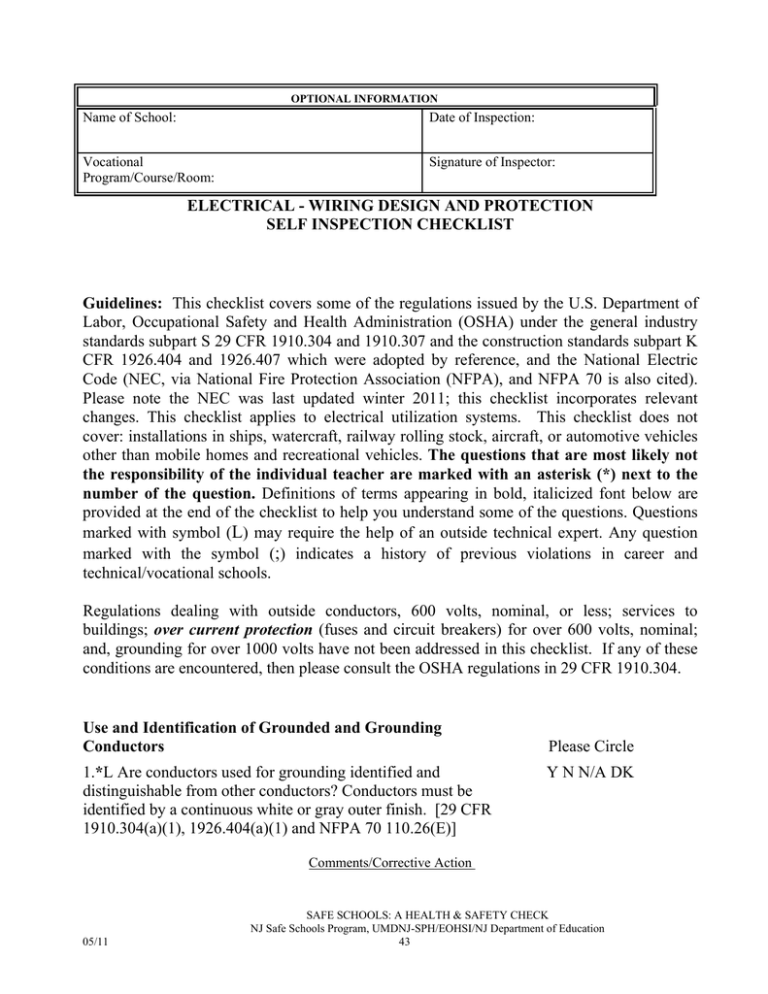
OPTIONAL INFORMATION Name of School: Date of Inspection: Vocational Program/Course/Room: Signature of Inspector: ELECTRICAL - WIRING DESIGN AND PROTECTION SELF INSPECTION CHECKLIST Guidelines: This checklist covers some of the regulations issued by the U.S. Department of Labor, Occupational Safety and Health Administration (OSHA) under the general industry standards subpart S 29 CFR 1910.304 and 1910.307 and the construction standards subpart K CFR 1926.404 and 1926.407 which were adopted by reference, and the National Electric Code (NEC, via National Fire Protection Association (NFPA), and NFPA 70 is also cited). Please note the NEC was last updated winter 2011; this checklist incorporates relevant changes. This checklist applies to electrical utilization systems. This checklist does not cover: installations in ships, watercraft, railway rolling stock, aircraft, or automotive vehicles other than mobile homes and recreational vehicles. The questions that are most likely not the responsibility of the individual teacher are marked with an asterisk (*) next to the number of the question. Definitions of terms appearing in bold, italicized font below are provided at the end of the checklist to help you understand some of the questions. Questions marked with symbol (L) may require the help of an outside technical expert. Any question marked with the symbol (;) indicates a history of previous violations in career and technical/vocational schools. Regulations dealing with outside conductors, 600 volts, nominal, or less; services to buildings; over current protection (fuses and circuit breakers) for over 600 volts, nominal; and, grounding for over 1000 volts have not been addressed in this checklist. If any of these conditions are encountered, then please consult the OSHA regulations in 29 CFR 1910.304. Use and Identification of Grounded and Grounding Conductors 1.*L Are conductors used for grounding identified and distinguishable from other conductors? Conductors must be identified by a continuous white or gray outer finish. [29 CFR 1910.304(a)(1), 1926.404(a)(1) and NFPA 70 110.26(E)] Please Circle Y N N/A DK Comments/Corrective Action 05/11 SAFE SCHOOLS: A HEALTH & SAFETY CHECK NJ Safe Schools Program, UMDNJ-SPH/EOHSI/NJ Department of Education 43 2.*; Have grounded conductors maintained the designated polarity when attached to a terminal or lead? [29 CFR 1910.304(a)(2) and 1926.404(a)(2)] Y N N/A DK Note: Electrical outlets (receptacles) when tested with a circuit analyzer should not show a reversed polarity, open neutral or neutral reversed with any other line. 3. Is the use of a grounding terminal, or a grounding-type device on a receptacle, cord connector or plug attachment prohibited except for the purpose of grounding? [29 CFR 1910.304(a)(3) and 1926.404(a)(3)] Y N N/A DK Over Current Protection 600 Volts, Nominal, or Less 4.* Are conductors and equipment protected from over current in accordance with their ability to safely conduct current? [29 CFR 1910.304(e)(1)(i) and 1926.404(e)(1)(i)] 5.*L Are over current devices (except for motor running overload protection) designed so as to not interrupt the continuity of the grounded conductors unless the conductors of the circuit are opened simultaneously? [29 CFR 1910.304(e)(1)(ii) and 1926.404(e)(1)(ii)] 6.* Are disconnecting means provided for (a) cartridge fuses (except for service fuses) accessible to other than qualified persons; and, (b) fuses and thermal cutouts on circuits over 150 volts to ground? [29 CFR 1910.304(e)(1)(iii) and 1926.404(e)(1)(iii)] Y N N/A DK Y N N/A DK Y N N/A DK Comments/Corrective Action 7.* 05/11 Is the disconnecting means installed so that the fuse or thermal cutout can be disconnected from its supply without disrupting service to the equipment and circuits unrelated to those protected by the over current device? [29 CFR 1910.304(e)(1)(iii) and 1926.404(e)(1)(iii)] Y N N/A DK SAFE SCHOOLS: A HEALTH & SAFETY CHECK NJ Safe Schools Program, UMDNJ-SPH/EOHSI/NJ Department of Education 44 8.* Are over current devices readily accessible to authorized personnel? [29 CFR 1910.304(e)(1)(iv) and 1926.404(e)(1)(iv)] Y N N/A DK 9.* Over current devices shall be protected from physical damage by installation in enclosures, cabinets, cutout boxes, or equipment assemblies. Or, as another option, these devices should be mounted on open-type switch boards, panel boards, or control boards in rooms or enclosures free from both dampness and easily ignitable material and that are only accessible by qualified personnel. Is this the case? [29 CFR 1910.304(e)(1)(iv), 1926.404(e)(1)(iv) and NFPA 70 240.83(D)] Y N N/A DK 10.* Are fuses and circuit breakers located or shielded so people will not be burned or otherwise injured by their operation? [29 CFR 1910.304(e)(1)(v) and 1926.404(e)(1)(v)] Y N N/A DK 11.* Are circuit breakers clearly indicated as to whether they are in the open (off) or closed (on) position? [29 CFR 1910.304(e)(1)(vi)(A) and 1926.404(e)(1)(vi)(A)] Y N N/A DK 12.* When circuit breaker handles on switchboards are operated vertically rather than horizontally or rotationally, is the up position the closed (on) position? [29 CFR 1910.304(e)(1)(vi)(B) and 1926.404(e)(1)(vi)(B)] Y N N/A DK 13.* Circuit breakers used as switches in 120-volt and 277-volt fluorescent lighting circuits shall be listed and shall be marked “SWD” or “HID.” Circuit breakers used as switches in high-intensity discharge lighting circuits shall be listed and shall be marked as “HID.” Is this the case? [29 CFR 1910.304(e)(1)(vi)(C), 1926.404(e)(1)(vi)(C) and NFPA 70 240.83(D)] Y N N/A DK Comments/Corrective Action 14.* 05/11 Are over current devices legibly marked so as to indicate purpose? CFR 1910.303(f)] Y N N/A DK SAFE SCHOOLS: A HEALTH & SAFETY CHECK NJ Safe Schools Program, UMDNJ-SPH/EOHSI/NJ Department of Education 45 [29 Grounding NOTE: AC means alternating current, and DC means direct current. 15.*L Are neutral conductors grounded in three-wire DC systems? [29 CFR 1910.304(f)(1)(i) and 1926.404(f)(1)(i)] Y N N/A DK 16.*L Are two-wire DC systems operating at 50 volts to 300 volts between conductors grounded? [29 CFR 1910.304(f)(1)(ii) and 1926.404(f)(1)(ii)] Y N N/A DK Note: Exceptions to this requirement are permitted when a) they supply only industrial equipment in limited areas and are equipped with a ground detector; or, b) they are fire-protective signaling circuits having a maximum current of 0.030 amperes. 17.*L Are AC circuits of less than 50 volts grounded when (a) they are installed as overhead conductors outside of a building; or, (b) they are supplied by transformers and the transformer primary supply system is ungrounded or exceeds 150 volts to ground? [29 CFR 1910.304(f)(1)(iii) and 1926.404(f)(1)(iii)] Y N N/A DK 18.*; Are AC systems of 50 volts to 1,000 volts grounded? [29 CFR 1910.304(f)(1)(iv) and 1926.404(f)(1)(iv)] Y N N/A DK Note: See OSHA regulations for possible exemptions to this requirement. Note: Electrical outlet receptacles should not indicate an open ground when tested with a circuit analyzer. 19.*L For AC premises wiring systems, is the identified conductor grounded? [29 CFR 1910.304(f)(2) and 1926.404(f)(4)] Y N N/A DK Comments/Corrective Action 20.*L When systems are grounded, is a grounding electrode conductor used to connect both the equipment grounding conductor and the grounded circuit conductor to the grounding electrode? [29 CFR 1910.304(f)(3)(i) and 1926.404(f)(5)(i)] Y N N/A DK Note: This is only determined at the main service or vault. 05/11 SAFE SCHOOLS: A HEALTH & SAFETY CHECK NJ Safe Schools Program, UMDNJ-SPH/EOHSI/NJ Department of Education 46 21.*L Are both the equipment grounding conductor and the grounding electrode conductor connected to the grounded circuit conductor either (a) on the supply side of the service disconnecting means, or (b) on the supply side of the system disconnecting means or over current device if the system is separately derived? [29 CFR 1910.304(f)(3)(i) and 1926.404(f)(5)(i)] Y N N/A DK 22.*L On service-supplied systems not grounded, is the equipment grounding conductor connected to the grounding electrode conductor at the service equipment? [29 CFR 1910.304(f)(3)(ii) and 1926.404(f)(5)(ii)] Y N N/A DK 23.*; Is the path to ground from circuits, equipment, and enclosures permanent and continuous? [29 CFR 1910.304(f)(4) and 1926.404(f)(6)] Y N N/A DK 24.*L Are metal cable trays, metal raceways and metal enclosures for conductors grounded? [29 CFR 1910.304(f)(5)(i) and 1926.404(f)(7)(i)] Y N N/A DK Note: See OSHA regulations for possible exemptions to this requirement. 25.*L Are metal enclosures for service equipment grounded? [29 CFR 1910.304(f)(5)(ii) and 1926.404(f)(7)(ii)] Y N N/A DK Comments/Corrective Action 05/11 SAFE SCHOOLS: A HEALTH & SAFETY CHECK NJ Safe Schools Program, UMDNJ-SPH/EOHSI/NJ Department of Education 47 26.*L Are the following appliances grounded: frames of electric ranges, wall-mounted ovens, counter-mounted cooking units, clothes dryers, refrigerators, freezers, air conditioners, kitchen waste disposals, hand-held motor-operated tools, any other motor-operated devices, portable hand lamps, tools likely to be used in wet and conductive locations, and metal outlets or conjunction boxes which are part of the circuit for these appliances? [29 CFR 1910.304(f)(5)(iii), 1926.404(f)(5)(iii), and NFPA 70 250.114] Y N N/A DK NOTE: If yes, then list which are present and grounded: ______________________________ NOTE: If no, then list which are present but not grounded: ____________________________ And, which (if any) are present and grounded: ________________________ 27 Exposed non–current-carrying metal parts of fixed equipment likely to become energized should be connected to the equipment grounding conductor under any of the following conditions listed below. Is this the case? (1) Where within 2.5 m (8 ft) vertically or 1.5 m (5 ft) horizontally of ground or grounded metal objects and subject to contact by persons; (2) Where located in a wet or damp location and not isolated; (3) Where in electrical contact with metal; (4) Where supplied by a metal-clad, metal-sheathed, metal-raceway, or other wiring method that provides an equipment ground, except as permitted by 250.86, Exception No. 2, for short sections of metal enclosures; and/or (5) Where equipment operates with any terminal at over 150 volts to ground. [29 CFR 1910.304(f)(5)(iv), 1926.404(f)(7)(iii), and NFPA 70 250.110] Y N N/A DK 28.*; Are exposed non-current-carrying metal parts of cord and plug connected equipment grounded? [29 CFR 1910.304(f)(5)(v) and 1926.404(f)(7)(iv)] Y N N/A DK Note: This applies to metal cases of tools and equipment except if double insulated. 29.*L When required, are the non-current-carrying metal parts of fixed equipment grounded by an equipment grounding conductor which is contained in the same raceway, cable, or cord, or runs with or encloses the circuit conductors? [29 CFR 1910.304(f)(6)(i) and 1926.404(f)(8)(i)] Y N N/A DK Note: For DC circuits only, the equipment grounding conductor may be run separately from the circuit conductors. 05/11 SAFE SCHOOLS: A HEALTH & SAFETY CHECK NJ Safe Schools Program, UMDNJ-SPH/EOHSI/NJ Department of Education 48 Hazardous Locations 30. Are any equipment, wiring methods and installations of equipment present in hazardous (classified) locations intrinsically safe, approved for the hazardous location, and safe for the hazardous location? [29 CFR 1910.307(b) and 1926.407(b)] Y N N/A DK Comments/Corrective Action 31. Is equipment approved not only for the class of location but also for the ignitable or combustible properties of the specific gas, vapor, dust, or fiber to be present? [29 CFR 1910.307(b)(2)(i) and 1926.407(b)(2)(i)] Y N N/A DK 32. Is equipment in a hazardous location marked to show the class, group and operating temperature? [29 CFR 1910.307(b)(2)(ii) and 1926.407(b)(2)(ii)] Y N N/A DK 33. Are conduits threaded and made wrench-tight? [29 CFR 1910.307(c) and 1926.407(c)] Y N N/A DK 05/11 SAFE SCHOOLS: A HEALTH & SAFETY CHECK NJ Safe Schools Program, UMDNJ-SPH/EOHSI/NJ Department of Education 49 Definitions: Disconnecting means signifies a device, or group of devices, or other means by which the conductors of a circuit can be disconnected from their source of supply. Ground-fault circuit interrupter (GFCI) is a fast-acting circuit breaker which senses small imbalances in the circuit caused by current leakage to ground and, if a fraction of a second, shuts off the electricity. Grounded means connected to earth or to some conducting body serving in place of the earth. Grounded conductor means a system or circuit conductor intentionally grounded. Grounding conductor means a conductor used to connect equipment or the grounded circuit of a wiring system to a grounding electrode or electrodes. Hazardous (classified) locations means areas which have volatile flammable liquids or excessive dust which could represent a significant fire or explosion hazard. Such locations are assigned six designations as follows: Class I, Division 1; Class I, Division 2; Class II, Division 1; Class II, Division 2; Class III, Division 1; and Class III, Division 2. Over current means any current in excess of the rated current of equipment or the ampacity of a conductor. It may result from overload, short circuit, or ground fault. A current in excess of rating may be accommodated by certain equipment and conductors for a given set of conditions, thus rules for over current protection are specific for particular situations. Over current protection means a device such as a fuse or circuit breaker used to prevent an over current. Raceway means a channel designed expressly for holding wires, cables, or busbars, with additional functions as permitted. Raceways may be of metal or insulating materials, and the term includes rigid metal conduit, rigid nonmetallic conduit, intermediate metal conduit, liquid tight flexible metal conduit, flexible metallic tubing, flexible metal conduit, electrical metallic tubing, underfloor raceways, cellular concrete floor raceways, cellular metal floor raceways, surface raceways, wireways, and busways. Service means or refers to the conductors and equipment for delivering energy from the electricity supply system to the wiring system of the premises served. 05/11 SAFE SCHOOLS: A HEALTH & SAFETY CHECK NJ Safe Schools Program, UMDNJ-SPH/EOHSI/NJ Department of Education 50

